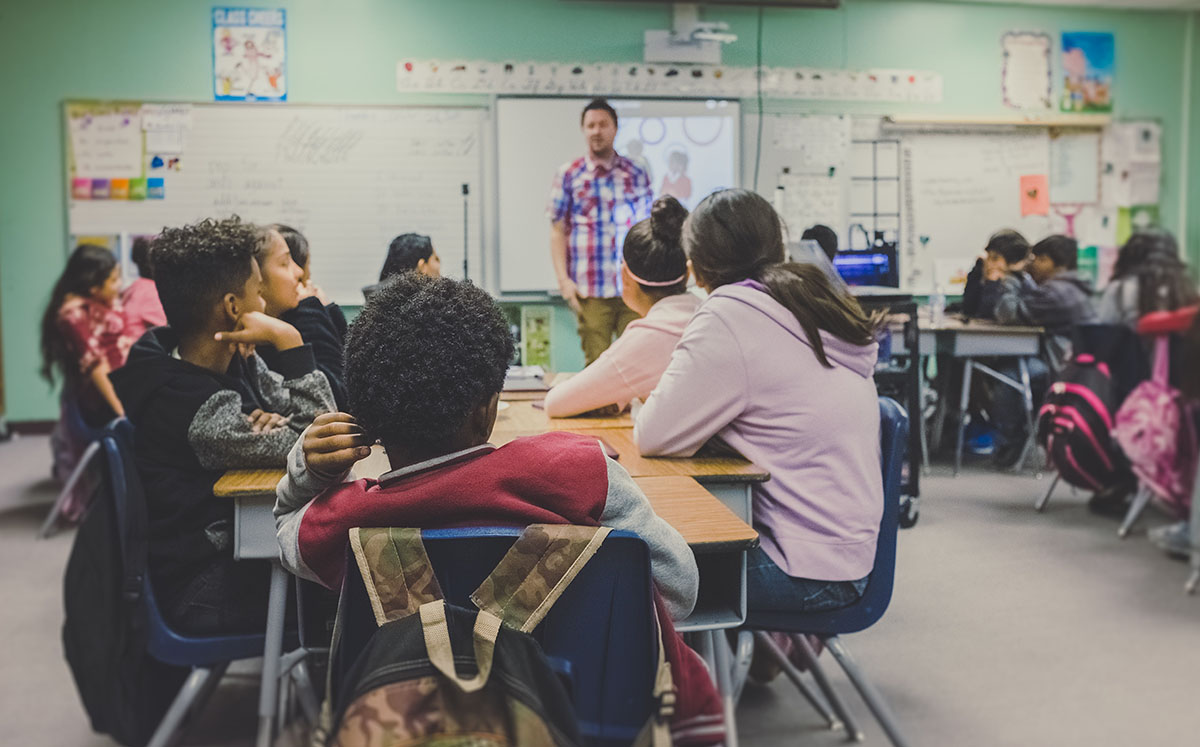The Gurian Institute (GI) is proud to be expanding its Head Start Pilot programs in Phoenix, AZ. The two year GI Pilot at Cartwright Early Childhood Center is completing this year (more on its results in a moment) and new Pilots at Arizona State University Early Childhood School, Byron Barry Early Childhood School, and Booker T. Washington Early Childhood School are underway.
The Pilots are a collaboration between the Gurian Institute, the City of Phoenix Human Services Department, Greater Phoenix Urban League Head Start Programs, Arizona State University, and the Booker T. Washington Schools; they serve primarily minority boys and girls in early education. They involve more than 25 classrooms, most of them coed but including one boy-only and one girl-only.
The Cartwright School has fulfilled the designation of Gurian Model School and is re-certifying as a Model School at the end of the 2021-2022 school year. Covid is always an unknown, but if in person learning continues, the other schools are on target for Model School designation at the end of this school year, as well. Head Start Program Coordinator Marion Hill, the first administrator to ask for the Model School Pilots, told Michael Gurian when these pilots began: “From the beginning, I have seen our work with GI in the context of helping minority children and families under the Equity and Excellence project of the National Urban League. The success of the first year of our Cartwright pilot with GI has been stunning. We are honored to become a Model School.”
Even during online Covid learning (the 2020 – 2021 + school years), the Pilots have elicited good anecdotal results. Head Start evaluation components were suspended federally, so Head Start’s CLASS and Teaching Strategies data were not collected last year, but local internal data was collected. We found that even when teachers practiced helpful learning strategies online, children learned better, especially boys of color in literacy areas and girls of color in STEM areas, according to Greater Phoenix Urban League COO, Natalie Alvarez and Education Coordinator, Dr. Ariana Lopez.
Ms. Alvarez told us recently, “We are proud of the success we are seeing in the Pilot classrooms, even through Covid schooling, and will continue to gather data and expand the Pilots into more classrooms. Especially with anti-racism compliance in federal programs, we see the GI Pilots as supporting both basic child development needs and also the empowerment of staff and children of color. We are impressed with the data we are seeing and committed to expanding access to the success components of these GI teaching strategies.”
Dr. Lopez confirmed Ms. Alvarez’s assessment, “Online schooling is not preferred, but it was mandated, and the Gurian strategies were helpful in keeping children and families involved in learning at home. We are glad to be back in school now, utilizing the strategies in person again and collecting data again. As it has done in previous years, the data again looks very good for the Pilot classrooms. What started as Pilots to address preschool-to-prison pipeline issues has expanded to include each of the Head Start learning components.”
Marion Hill, Dr. Lopez, and many others who are working in the Pilots will speak at our Summer Training Institute this June. To learn more about our event and to register, visit: https://gurianinstitute.com/events/gurian-summer-institute-2022/.
GI Pilots Include these Rationale, Methods, and Guiding Questions.
Rationale for the Pilot: Research and anecdotal evidence show areas of concern in early childhood environments, especially surrounding the failure rate of boys in general and boys of color specifically, including the pre-school to prison pipeline.
The Gurian Institute (GI) Method: Via its original 2-year pilot in six school districts facilitated by Michael Gurian and faculty at the University of Missouri-Kansas City School of Education (1998-2000), the Gurian Method was proven successful in minimizing areas of concern, decreasing failure rates, and increasing teacher effectiveness. GI has since co-facilitated pilots and programs throughout the world, including in Phoenix beginning in 2019.
Guiding Questions: The method and pilot works one classroom at a time to answer these questions:
*How do female and male brains differ in learning, behavior, and social emotional development?
*Based on those differences, how do we best nurture the nature of boys, girls, and every child?
*To support that nurturing, how do we change our micro-cultures to provide success for every child?
*How do issues of equity, race, and gender affect teaching, family, and parent outcomes in the context of the preceding three questions?
A Case Study: The Cartwright Model School Pilot
During the summer of 2019, along with normal PD in the school districts, all Cartwright teachers, staff, social workers, case managers, and teachers aides attended a two day Boys and Girls Learn Differently Training that provided foundational learning in male/female brain difference, nurturing patterns, aggression and physicality levels, responses to trauma and cultural differences, and racial and cultural sensitivity. During this training, staff were provided with multiple strategies and tools to employ during the school year.
During the school year, Gurian Institute Master Trainer Eva Dwight provided on-site consulting, observation/feedback, instructional support, and technical assistance. Eva was joined by GPUL/Head Start staff Mr. Hill, Ms. Alvarez, Marlene Ordaz, Shandeen Gomez, and Dr. Lopez who work on site already and are certified Gurian Trainers. This team provided day-to-day support including development and deployment of dozens of implementation and action strategies for trauma-response, literacy improvement, STEM improvement, behavior management, sex-specific bonding and attachment, racial and cultural sensitivity, and much more.
As the year progressed (interrupted towards the end by COVID protocols), Dr. Ariana Lopez joined the team. Throughout the year (and continuing into this year) teachers and staff kept journals of interactions, strategy implementation, pros and cons, what worked and what didn’t, how things worked, how parents’ and children’s interactions shifted, and what organically emerged from the work in the classrooms and then online.
As it had been in the University of Missouri pilot (captured in the book Boys and Girls Learn Differently) and confirmed in more recent GI programs, these teacher journals were important for the implementation and assessment of school development. Here are some journal entries that illustrate the process and pilot results.
“In the past, we’ve been taught to put the children in pairs with partners. This was not working well with boys. After learning more about boys this year, we decided to just have the boys walk in a line marching to the song ‘The Ants Go Marching In.’ The boys really enjoy this new routine. They are well-disciplined when doing this routine.”
“A new strategy we used to help with literacy was, during lunch time, the teacher reads the book of the day to the kids. The children focused better on hearing and listening to the story during lunch, especially boys who had trouble earlier. Now some of these children verbally recall more parts of the story. This worked better than trying to read to them on the mat with children spread out and distracted by objects around them.”
“When we did our insect unit, we wanted the girls to be more engaged in how insects grow, change and reproduce so, when we went outside, we provided our kids with magnifying glasses, and they were looking around for insects in the playground. We saw that they enjoyed looking for insects. We are doing this along with other engagement for girls outdoors, for instance, by doing bilateral movement– rock climbing wall, hanging rings; balancing pods, beams; imaginative play; sensory/tactile – pea gravel, sand with buckets, digging material, insect exploration; large motor – hula hoops, balls; free play and competition when possible.”
“We did ‘Opposite Day’ in which the girls were asked to stay in the block area as the boys stayed in the art area to create cards for their mothers. The girls were presented with images of castles and were also given props to add to their castles. From the 9 girls who came to class, only 3 had trouble building a castle, while the rest built, destroyed and then built again.”
“We started implementing the ‘ask’ instead of ‘tell’ strategy that the GI team leader taught us. We have started asking the children what they should be doing instead of telling them. In doing this, we have noticed that the children know what they should be doing, and they are able to tell us. By asking them, they feel like they are in control and have the say-so of what they should be doing. Also, they remind their friends of what they should be doing when they notice that they are not following the rules. This practice is now a part of our routine.”
“During online schooling, we still worked hard to keep the boys at home moving around, doing brain breaks, and doing project-based learning. We also coached parents in how to help them stay engaged. With three to four year old boys through a screen this is especially hard, but teaching parents to let boys roll around on the floor while listening to a book–and seeing that the boys did comprehend the book this way–was eye-opening for many parents.”
Evaluation of the Classroom, School, and Pilot
Evaluation of the strategies and implementation occurs anecdotally through journals and statistically through Head Start evaluators and structures which include CLASS, Teaching Strategies, and e-Deca. On site evaluators are already employed in the school system, providing evaluation on site at various intervals, and specifically at the end of 3 three month intervals (fall, winter, spring). At Cartwright, 2019 – 2020 evaluation showed significant improvement in most behavioral and academic areas statistically, with anecdotal support for the success provided by teacher journals, parent feedback, and case manager assessment.
Two major components of both Head Start goals and the Pilot itself–literacy and behavior management–showed significant improvement. Math showed improvement, as well, and decrease in gender stereotyping also grew as the pilot went on. This latter point is a crucial one in the contemporary educational landscape. For decades, Gurian Institute research from school districts across the country has shown a decrease not increase in gender stereotyping when sex-differences are accounted for in pedagogy. Cartwright’s pilot confirmed this finding. Boys developed more hands-on empathic social skills and reading improvement, and girls developed more use of early childhood engineering interests and object-structure based play.
Among the many people to thank for the work at Cartwright is Marion Hill, Head Start Director in Phoenix. Marion Hill and Michael Gurian met a number of years ago at a Head Start conference in Phoenix, realizing immediately their shared goals in gender and racial equity. Over the last number of years, Marion has founded, headed and supported the M.A.N.C.A.V.E. program as well, a program for fathers of young children in black and Latino communities.
We are grateful to all of the Pilot staff, including teachers, coaches, and social workers, as well as the Governing Boards of the Greater Phoenix Urban League and Booker T. Washington. To learn more about the Cartwright School Pilot as well as our Model School program, please visit the GI Model Schools page on www.gurianinstitute.com. As data comes in from the new Byron Barry, ASU Prep, and Booker T. Washington pilots, we will share it with you.
To bring Gurian Institute Pilots to your community, write us at gail@gurianinstitute.com. To hear more from the Pilot teams about strategies and system changes, check out the keynotes and workshops at our Summer Training Institute. For more information and to register, visit: https://gurianinstitute.com/events/gurian-summer-institute-2022/.










